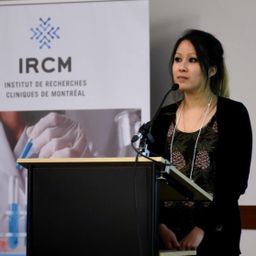Exploiting the conformational regulation of ELMO proteins reveals that myoblast fusion can be exploited for regenerative therapies in muscle diseases
My Session Status
Exploiting the conformational regulation of ELMO proteins reveals that myoblast fusion can be exploited for regenerative therapies in muscle diseases
Tran V1,2, Thibault M-P1, Killoran R2,3, Smith M J2,3 and Côté JF1,2,4.
1Montreal
Clinical Research Institute (IRCM).
2 Université de
Montréal
3 Institute for
Research in Immunology and Cancer (IRIC)
4 McGill University
Myoblast fusion during myogenesis is central to the formation of multinucleated fibres. We recently mapped a pathway involved in this cellular process, where DOCK1 plays an evolutionarily conserved role. We also showed that BAI3 promotes fusion by engaging DOCK1-RAC signalling via ELMO. Mechanistically, we established that ELMO switch between open/closed conformations, therefore providing a molecular checkpoint for RAC activation by DOCK1. Hence, our hypothesis is that ELMO1/2 are key regulators of myoblast fusion and that manipulating their conformational state offers an opportunity to test if increasing the activity of the ELMO/DOCK1/RAC pathway can improve muscle regeneration. We investigated whether ELMO is required for embryonic myoblast fusion and we could demonstrate a severe block in fusion when ELMO1/2 were eliminated. This led us to investigate if manipulating the activity of the ELMO/DOCK1/RAC pathway may promote regeneration. We generated knock-in mice in which Elmo2 is maintained in an inactive (Elmo2RBD) or active (Elmo2EID) conformation. Analysis of Elmo2EID muscle showed larger fibres, suggesting that up-regulation of the pathway activity enhances muscle growth. We also found that CTX-induced muscle damage regenerates more efficiently in these mice. Conversely, we observed that decreasing the pathway activity decreased the efficiency of regeneration. Finally,interbreeding of Elmo2EID with DysferlinKO mice (mouse model of the Limb-Girdle Muscular Dystrophy type 2B) could rescue their dystrophic phenotype.Collectively, our work revealed a critical role for ELMO in myoblast fusion and provides a proof of concept that activation of signalling pathways promoting fusion may provide therapeutic opportunitiesfor the treatment of myopathies.
